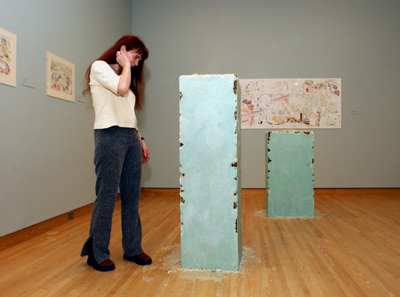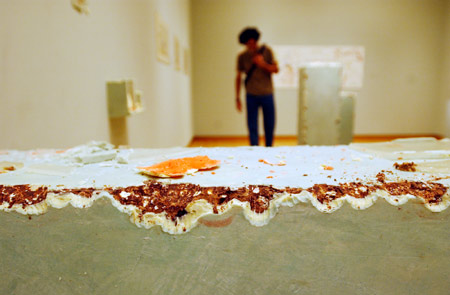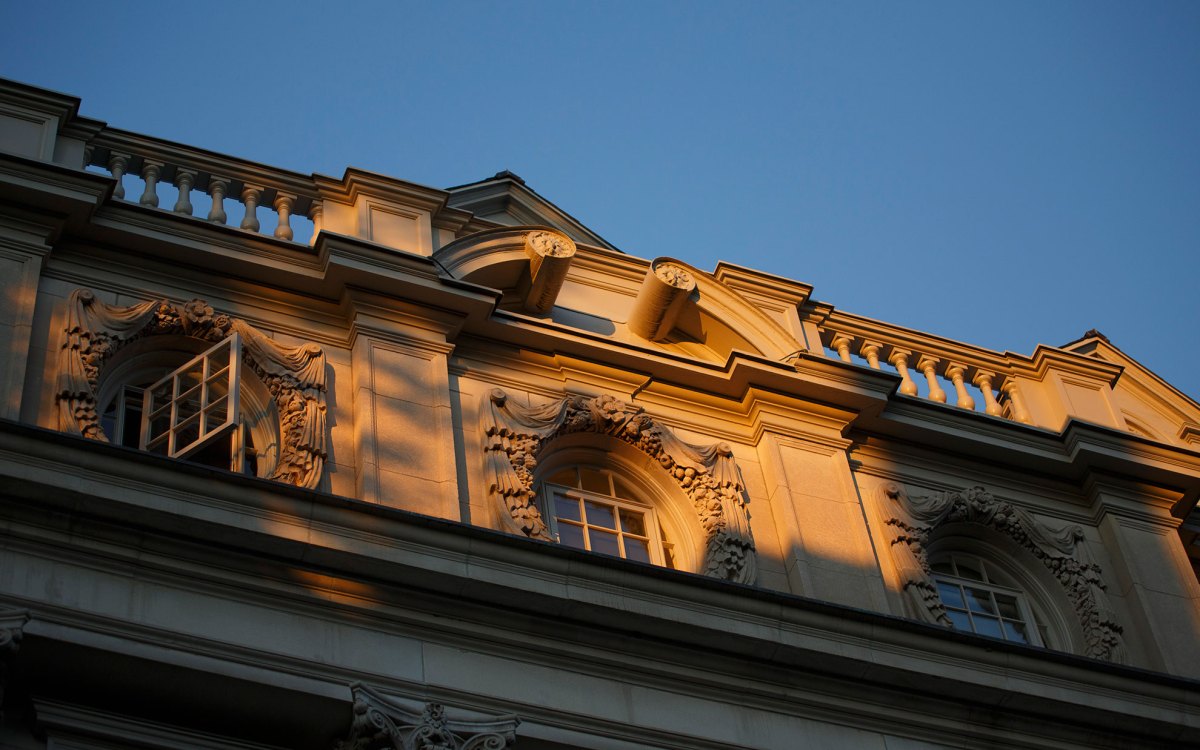Eat art!
The Busch-Reisinger serves up some brand new aesthetic fare

Sonja Alhäuser loves to cook. She loves the heightened awareness that cooking demands, loves to bring different ingredients together and come up with something new and, if all goes well, delicious.
But she is very clear about the difference between cooking for the table and the edible artworks she has created for the current exhibition at the Busch-Reisinger Museum, “Eat Art.”
“I want to show both sides,” she said, struggling to express herself in English. “It is tasty, yes, but at the same time it is horrible because the artwork is being destroyed. If I bake a cake, no one will ask why is it destroyed?”
Alhäuser lives and works near Düsseldorf, Germany. She came to Harvard two weeks ago to create a group of artworks for the exhibition using 800 pounds of chocolate, 60 pounds of caramel, several huge bags of popcorn, and a large tin of marzipan. The works are edible, and they are meant to be eaten. Alhäuser hopes that when the exhibition closes three months from now, there will be nothing left.
The experiment is off to a good start. Already, on the second day, the caramel vitrines have been smashed, the marzipan sculptures that rested inside have been devoured, and the chocolate pedestals, dyed pale green with food coloring to match the nonedible pedestals that hold works by other artists, have been gouged and graffitied. There are even places on the corners where you can see tooth marks.
“It makes me feel a little sad,” Alhäuser said. “But I am also happy how the colors look, how it changes without my help.”
Alhäuser’s work and the works of the other two German artists that make up this exhibition – Dieter Roth and Joseph Beuys – are all about process, and about the relationship between art and other aspects of life.
You see this in the large diary drawing Alhäuser has done to accompany her edible sculptures. She began it in Germany and completed it in the evenings while she was working on the exhibition, adding images from left to right. It shows her traveling by air to the United States, going through customs, picking up her luggage. Meanwhile, thought balloons above her head show globs of melting chocolate and the casting process she will use to transform it into art.

“I want to show that coming to the U.S. is as important as the exhibition. I think in pictures, everything at the same time. I want to tell a story, how this is just a short time in my life, a little stressful, and, how do you say? dense.”
Alhäuser, who was born in 1969, considers it a great honor to share a gallery with Roth and Beuys. Both of them taught at the school in Düsseldorf where she studied, although she never had a chance to meet them. The speedily devoured marzipan sculptures she created were portraits of these two highly influential artists. She feels that sculpting their images allowed her to commune with them.
Beuys (1921-1986) created works that seem simple, almost inconsequential, but which carry an enormous burden of philosophical and political meaning.
“Beuys believed that art objects are vehicles to talk about a change in society,” said Tanja Maka, the Michalke Curatorial Intern at the Busch-Reisinger Museum. Maka, also German-born, is the organizer of the exhibition.
A large set of utility shelves hold a variety of Beuys’ artworks from the 1970s. Most of them look like products from some antiquated grocery store, and in some cases, that is exactly what they are. Beuys would buy containers of oil, honey, rice, and other everyday comestibles and transform them into works of art by scrawling his name on them or by adding the phrase “1 Wirtschaftswert,” meaning “one unit of economic value.” Others, a bottle of oil, for example, bear his own label, the Joseph Beuys brand.
“These works are a comment on the economic system,” Maka said. “Beuys believed that capitalism and socialism were both one-way streets. One of his most famous sayings was that every human being is an artist. He thought that in place of money we should substitute creativity.”
In Beuys’ symbolic system, a substance like honey is charged with meaning. To quote from the essay Maka wrote for the exhibition, “Honey is the product of a cooperative of bees, a small, well-ordered society working together to create life-giving nutrients. The activity of production itself creates warmth within the hive, helping to sustain life. This was a model for Beuys of how human society should function.”
A disciple of the philosopher and social theorist Rudolf Steiner, Beuys strove to embody his mentor’s theories about energy flows in his artwork. One example is Capri Battery, created in 1985 – an electric socket holding a yellow lightbulb is plugged into a lemon. The simple construction unites nature and culture and demonstrates that the latter is dependent on the former.
Dieter Roth (1930-1998) often incorporated food in his work, but without the portentous social and philosophical meanings that Beuys imposed on his creations. Roth’s object seems to have been created to perpetually challenge the viewer and himself. A filmmaker, musician, poet, and graphic designer as well as an artist, he once said that as soon as he became adept in a medium he gave it up. Otherwise, the object would become “too pretty.”
Few would accuse Roth’s artworks of being pretty. For example, there is “Self Portrait as a Lion” (1971), not a conventionally representational portrait at all. Nor does it look much like a lion, but rather like a misshapen puppy with an oversized head. It is sculpted in chocolate, and after 30 years it is somewhat the worse for wear due to fungus, insects, human fingers, and other agents of destruction. But from Roth’s point of view, this is nothing to be upset about.
“He wanted his artworks to live and die like humans,” Maka said. “He chose organic materials because the museum cannot preserve them. It undermines the mission of the museum.”
Other works undermine the museum’s mission in an even more spectacular fashion. “Big Cloud” (1971) is executed in fibre-tip ink and mayonaise on white wove paper. Over the years, the mayonaise has decayed or been eaten by microscopic organisms of one sort or another resulting in piles of unpleasant brown debris collecting at the bottom of the frame.
Another work, “Poëmeterei” (1968), consists of Roth’s poems printed on plastic bags containing minced mutton. A series of three works called “small sunset” (1972) show the sun going down over the ocean with the sun represented by a sausage slice under plastic. Over the years the grease from the sausage has seeped into the paper in different ways, creating different patterns. What is disconcerting about these sunsets is that from a few feet away they actually are pretty.
“On the one hand, it’s a joke on landscape painting,” said Maka. “They look pretty from a distance, then you go up close and you discover there are grease stains, mold, things that we are repelled by. You have to make your mind up.”
Making your mind up is what the exhibition as a whole forces the viewer to do. None of these artists make it easy, although a quotation from Beuys may give us some idea of the importance of the task:
“Wer nicht denken will, fliegt raus – sich selbst.” (He who does not want to think is expelled from himself.)
“Eat Art” will remain at the Busch-Reisinger Museum until Dec. 15.




